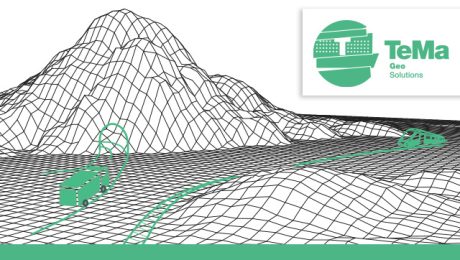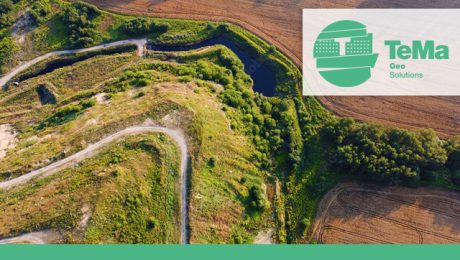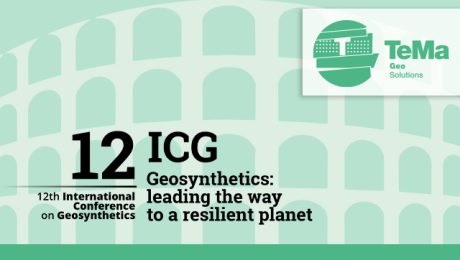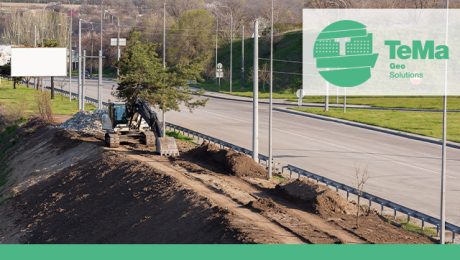TeMa Geo Solutions: geotechnical solutions
The TeMa Geo Solutions division has developed considerable experience in geotechnical applications and developed technologies and products, thereby ensuring that designers can meet increasingly strict regulations concerning the environment and the landscape.
These applications are for the protection, maintenance, retention, reinforcement and drainage in the field of major environmental projects, involving products that provide innovative efficient and long-lasting solutions.
We are aware that a kind of public resistance to sustainability announcements has already begun. We are therefore interested in helping companies that are taking appropriate action to protect the environment. This is not only to ensure that they can better comply with regulations but also, and above all, to increase the effectiveness and credibility of their work.
TeMa Geo solutions in applications
The areas of expertise of TeMa Geo Solutions include:
- football fields
- landfills and contaminated sites
- tunnels
- reinforced soil retaining structures
- dry slopes
- grassy road and railway embankments
- roads
- drainage ditches
- horse training and racing tracks.
Products and functions: a range starting with geosynthetics
Geogrids are structural elements used to reinforce soils in the construction of retaining walls, block retaining walls, reinforced soil retaining structures, landfills and contaminated sites. The open mesh structure allows the reinforcement geogrids to develop ‘passive’ resistance at the transverse ribs, thus effectively increasing their inherent stabilising effect and enabling the system to withstand significant levels of stress.
The TeMa Geo Solutions range includes uniaxial or biaxial X-Grid geogrids made of fibreglass, polyester or PET coated with a polymer layer, coupled, or not, with a nonwoven geotextile, to be chosen to suit the project.
Offering products such as bentonite geocomposites, drainage geocomposites, facings, erosion control mats and essential accessories, the TeMa Geo Solutions range fulfils various functions for the retention anddrainage of rainwater and groundwater.
The TeMa Geo world offers its long-standing (since 1993) expertise and experience in the polymer-based product category (geosynthetics). Over the years, research at its in-house labs has enabled the development of solutions that integrate with the environment in a more specific sense, such as biodegradable erosion control mats, and in a broader sense, such as geomats and studded membranes.
TeMa also offers cutting-edge geotechnical solutions for vineyards
This is not surprising, as the TeMa Geo headquarters are situated on the eastern edge of the Prosecco hills, a UNESCO World Heritage Site. The company therefore has made its experience available to preserve and protect the viticultural landscape with its products for erosion control, reinforcement and ground drainage in an environment subject to the passage of agricultural vehicles. Click here to download the specific catalogue.
- Published in Drainage geocomposites and membranes, Erosion mats, GEO, Geogrids, Landfills, Reinforced earth structures, Roads, Synthetic turf soccer fields - Accessories, Tunnels
Safety first: and that applies to landfills, too
TeMa Geo Solutions’ thirty years of experience extends to the field of controlled landfills and contaminated sites, with products specially designed for each function to ensure the site is safe, and with investment-conscious solutions, as well as a focus on ensuring peak performance.
Safe landfills legislation
In Italy, regulation around the controlled disposal of waste dates back as far as 1982, later supplemented by the European directive and updated in 2020 by Italian legislation (D.Lgs no.121).
This legislation covers all aspects of the disposal cycle, from landfill classification to the type of waste, as well as criteria for the construction and operation of the facilities, with a strong environmental focus. In this regard, TeMa has come up with built-up systems and materials that fulfil the required functions and comply with the relevant legislation.
The main functions to make safe a controlled landfill
Making safe a landfill facility entails fulfilling a number of functions:
![]() Barrier
Barrier
Walls and floor must be isolated to protect groundwater and soil from leachate and biogases resulting from decomposition processes. To ensure sufficient watertightness, legislation requires the use of at least 0.5 m of clay or, drawing on the principle of hydraulic equivalence, synthetic products: sodium bentonite composites like Barrier Bento — which contains up to 5 kg of bentonite/sqm sandwiched between two geotextiles — provide an impermeable layer, acting as a barrier between soil and waste.
![]() Reinforcement
Reinforcement
One of the major issues to be addressed when designing landfills, especially the capping system, is stability, which can be achieved by leveraging the compressive strength of the soil combined with the tensile strength of geosynthetics. Reinforcement solutions provided by TeMa range from PET-series geogrids to geomats laminated with geogrids.
![]() Drainage
Drainage
For liquid and gas capture, legislation calls for the use of 50 cm of aggregate, which nonetheless can come with its own stability issues, especially on steeper slopes. With the use of drainage geocomposites, the relevant built-up system can be pared back, while the number of vehicles required to carry materials can also be reduced. TeMa’s offering ranges from studded and micro-studded membranes to monofilaments laminated with nonwovens, and geonets with one or two nonwoven layers.
![]() Erosion control
Erosion control
The top layer of the soil is eroded by the action of the elements — especially by the type of unpredictable and extremely violent weather events we’ve witnessed in recent years — triggering alarming landslips, which can undermine a site’s hydrogeology. To prevent issues of this kind, it’s essential to encourage vegetation (which serves as a form of natural erosion control) and protect the soil while it takes root by using natural or synthetic mats from TeMa.
TeMa at the 12th International Conference on Geosynthetics.
We too will be at the 12th edition of the International Conference on Geosynthetics that will take place in Rome, at the Parco della Musica auditorium from 17 to 21 September 2023, and which will involve a full programme of meetings between professionals (further information about the events here).
Four days of training and information meetings on geosynthetics, exploring all sub-types: woven and non-woven geotextiles, geogrids, geonets, geomats, drainage and reinforcement geocomposites, and geomembranes.
Geosynthetics are becoming increasingly popular in applications and fulfil various functions (often combined). For example:
- Drainage – drainage geocomposites and geonets.
- Filtration and Separation – woven geotextiles and non-woven geotextiles.
- Reinforcement – woven geotextiles and geogrids.
- Protection of waterproofing – studded membranes with truncated conical or star-shaped studs.
- Erosion control – geonets, geomats, biotextiles.
- Mechanical protection – non-woven geotextiles, composite geotextiles.
- Special applications – various geosynthetics made to specific requirements.
The main topics discussed will cover various fields of application, including anti-seismic design to road and railway embankments, erosion control, filtration and drainage functions, as well as an analysis of case studies.
The world of research is continuously evolving and the scheduled meetings will provide an excellent opportunity for sharing experiences and recent technical developments with engineers, geologists, consultants, contractors and whoever is involved in research and using geosynthetics.
During the exhibition event visitors will be able to take part in technical conferences, the Giroud lecture, special lectures and short courses , as well as visit the exhibition hall to meet manufacturers.
TeMa has thirty years of experience in using geosynthetics
The international event, entitled ‘Leading the way to a resilient planet’, fully represents the reason why TeMa began to manufacture and experiment with geosynthetics from the mid-1990s onwards: to research the most suitable technologies and materials for use in the construction of buildings and geotechnical works.
We have been involved in continuous interaction, also due to an increased awareness of major environmental issues. This has enabled us to broaden our range of products and expand in 80 countries worldwide.
Today, our catalogue includes many products that meet specific requirements for landfills, tunnels, road embankments, river banks and reinforced earth structures, gradually increasing performance for surface erosion control, rainwater drainage, and the reinforcement of grassy slopes.
The geosynthetics sector is rapidly developing and we are making huge investments, especially in research, so as to supply our customers with the best solutions, also tailor-made, for their projects. We share the same ‘urgency’ as our partners to pursue our unwavering ideal of respecting the environment and the hydrogeological protection of the land.
We look forward to seeing you in Rome from 17 to 21 September 2023, at Stand 22.
Meanwhile, you can discover all the details about the event here.
Technical considerations in building reinforced soil walls
Reinforced soil walls have proved highly popular in recent years and are produced wherever possible, taking the place of concrete-faced soil retaining wall systems.
Employed in a range of different environments, they bring significant advantages, both financial and environmental. Indeed, unlike concrete-faced soil retaining wall systems, they:
- are sustainable because they give a vegetated finish;
- are a great space-saving solution, with slopes as steep as 80° (compared to the 30-40° of natural soil embankments);
- result in less pollution given the smaller number of trucks required to carry construction materials;
- make use of the excavated earth for backfilling, provided it is compatible with stability standards, meaning no more material needs to be brought in;
- blend seamlessly with their surroundings once the slopes are grassed over, without becoming a blot on the landscape of our villages.
Whatever the case, before planning the work, there are a number of aspects and data to be taken into consideration.
Preliminary data needed
To start with, all essential technical information must be procured in order to be able to assess the feasibility of the project, such as:
- geological testing of the area on which the wall is planned to be built
- topographical surveys
- meaningful cross-sectional drawings showing the current condition
- geometry of the planned wall (face angle, height, division into tiers, slope on top)
- external loads applied to the structure (top loads in the event it needs to accommodate a car park or a road)
- what earthquake risk zone the area is in
- geotechnical properties (angle of shearing resistance, cohesion and density) of the earth behind the future wall, of the foundation soil, and of the backfill
- whether there are perched aquifers or seepage of a different nature.
At this point, the next step is to check design calculations using specific software.
Checking design calculations
Checking is performed to assess both internal and external stability. The following tests are carried out in the former case:
- reinforcement strength test, which assesses possible failure mechanisms and determines the spacing, length and tensile strength of the geosynthetics due to be laid
- pull-out test to check that the reinforcement applied does not break or slide out
- direct sliding test, to ensure there is no translational movement across the installation planes
- wrap-around test, to ensure that the length wrapped around the top of each individual layer is stable.
The checks to be carried out during the project’s execution to assess external stability consist in sliding, overturning, bearing capacity and global failure analysis.
Do you want to chat with one of our experts to find the solution that best suits your requirements?
We have 30 years of experience in the industry and can give you access to materials and solutions offering specific performance. Contact us!
Do you want to learn more about the full TeMa Geo Solutions product range for reinforced earth structures? Click here.
New solutions in road construction and/or repairs
The safety of road infrastructures is the main goal, and maintenance work – whether preventive or supplementary – is systematic.
Road surfaces withstand heavy traffic loads and atmospheric changes with significant variations in temperature. Constant maintenance is therefore required in order to ensure even surfaces and the stability of structural elements.
Let’s look at the main factors involved in building new roads or maintaining roads.
Controlling surface erosion
Erosion is largely due to freeze/thaw cycles, which make asphalt less elastic and therefore more prone to internal voids. Such voids allow water to penetrate into underlying layers, gradually eroding the structure.
In addition, heavy traffic loads, especially heavy vehicles, cause deformation of the surface layers: this results in water penetration, which “softens” the structure and makes it less resistant.
Anti-capillary drainage
The water capillarity, i.e. the ability of liquids to move in micro-spaces even against the force of gravity, is a rather complex concept closely monitored in the construction industry. With the help of pressures exerted on lower layers, water rises upwards, dragging the finer components of materials with it and causing deformation.
It is therefore necessary to provide a drainage geocomposite, a three-dimensional membrane obtained by bonding two or more synthetic components in order to convey fluids to the exterior and prevent them from rising.
You can discover all our solutions here.
Reinforcement
It may sometimes be necessary to install reinforcement grids, especially if there is a more or less pronounced slope that would cause a road shoulder to slide downwards.
The choice of the most suitable type of reinforcement, and therefore also of the position of the geogrid in the layering, clearly depends on the problems to be faced i.e. reinforcing the surface area to limit the spread of cracks to underlying layers, improving the load-bearing capacity and reducing the stresses transmitted to lower layers, or providing a separation (and anti-contamination) function.
Discover all our solutions here.
Stabilisation
During intervention works, softer soils may be encountered, which may be subject to instability or even collapse in the early stages of intervention works. Even if this should not jeopardise the feasibility of the works, there is still the risk that the minimum legal safety requirements will be compromised.
Also in this case, geosynthetic products are the solution to the problem, as they absorb tensions at least until the intervention work achieves structural stability.
Discover the solutions in the X-Grid line here.
- Published in Drainage geocomposites and membranes, Erosion mats, GEO, Geogrids, Roads
Environmental intervention works in keeping with our philosophy
An environmental reappraisal
Over the centuries the relationship between man and the environment has undergone considerable tensions. Rural development and the impetus in building have undoubtedly disrupted certain landscapes, reducing natural spaces to accommodate new urban and agricultural areas. This type of intervention work has led to a crisis in the ecosystem, imposing re-evaluation of the fragile balance between the economy and the environment.
This is the socio-cultural background that has led to global re-assessment aimed at defining programmes and new territorial management formulas. It has been the driving force behind TeMa Geo Solutions, the TeMa business unit dedicated to environmental intervention works. These are aimed at protecting land and offering the opportunity to operate using eco-compatible solutions and products that integrate into the environment without compromising its appearance or safety.
Sustainable development according to TeMa
Nestled at the foot of the hills declared a UNESCO World Heritage Site, the TeMa headquarters could not help but consistently correspond to this desire for sustainability, widespread in this area for some years now. But how has it contributed? By using raw materials responsibly, with 100% natural solutions and intervention procedures with low environmental impact.
Natural products
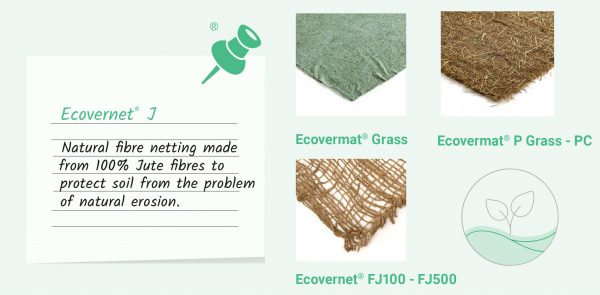
As a concrete example, TeMa addresses the problem of surface erosion of the soil by meteoric rain with Ecovernet® in natural fibres such as jute or Ecovermat® in natural fibres such as straw and coconut – or in biodegradable cellulose fibre. Installing products in this range allows intervention works to be carried out immediately, even in situations with difficult access for on-site vehicles. For such types of intervention works, total integration with the soil is achieved, guaranteeing lasting results over time.
Green intervention works
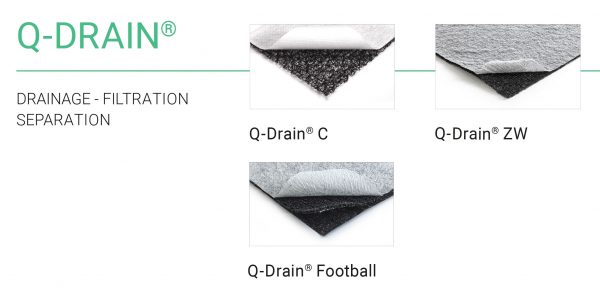
An interesting new development introduced by our technicians is the use of lightweight materials that feature reduced encumbrance, which not only affects the cost of the work but also speeds up the time required on-site. When building drainage systems, for example, TeMa does not rely on that range of inert materials from quarries that need to be extracted and transported. The company uses drainage geocomposites instead, such as Q-Drain, thus avoiding any waste of energy and CO₂ emissions into the air, thus ensuring quick installation.
These are just a few examples to show the potential that the field of environmental engineering has to offer:
- Reduction in costs while maintaining the effectiveness of intervention works
- Sustainability of the actions taken
- Protection and safeguarding of the soil
- Promotion of natural raw materials
To fully understand our philosophy, browse through the new catalogue dedicated to the protection of vineyards, which are the natural and cultural heritage of our lands and an identifying feature of our history. Inside it, you will find products and solutions for responsible and eco-compatible actions.
- Published in Drainage geocomposites and membranes, Erosion mats, GEO, Research and development

